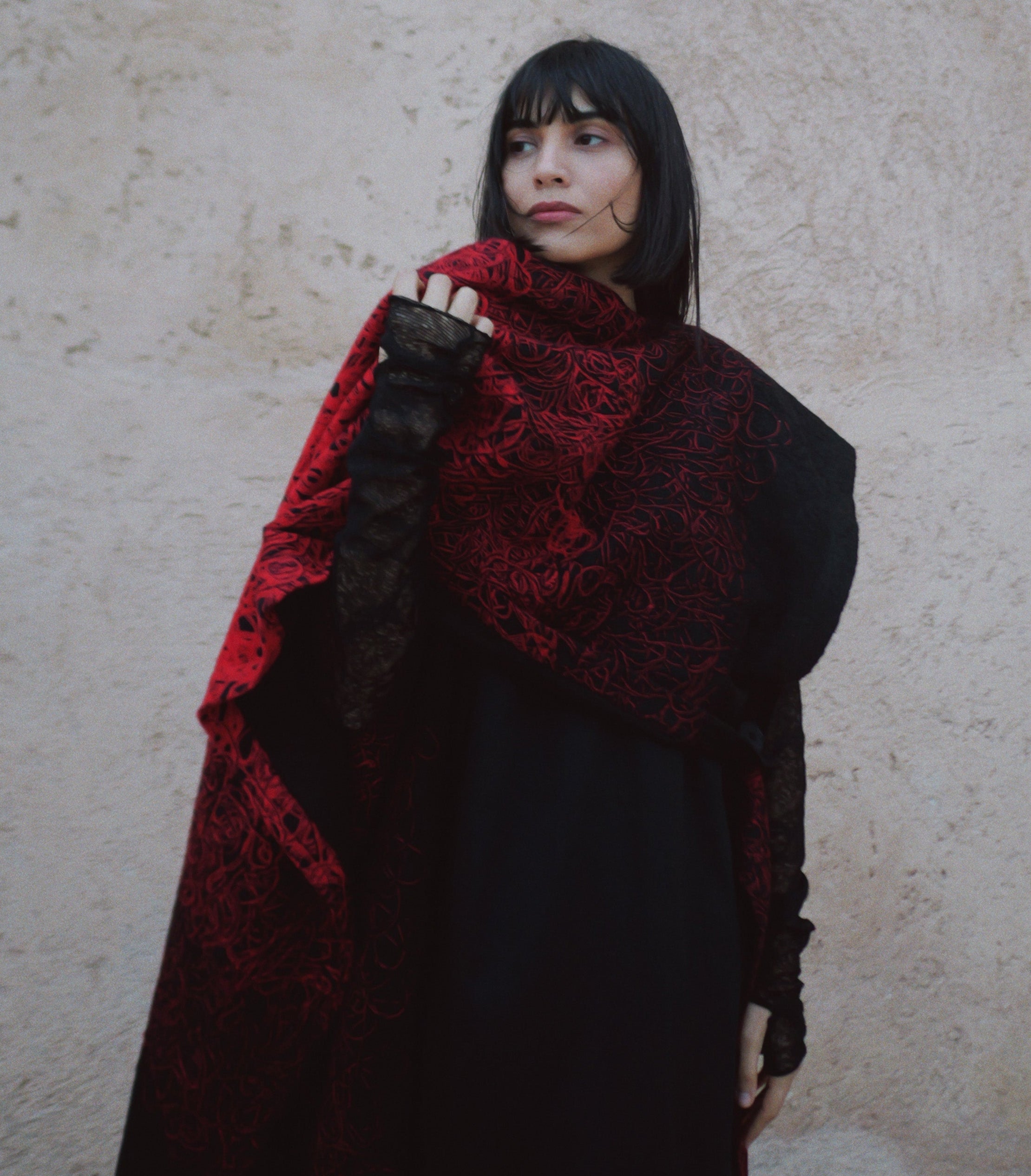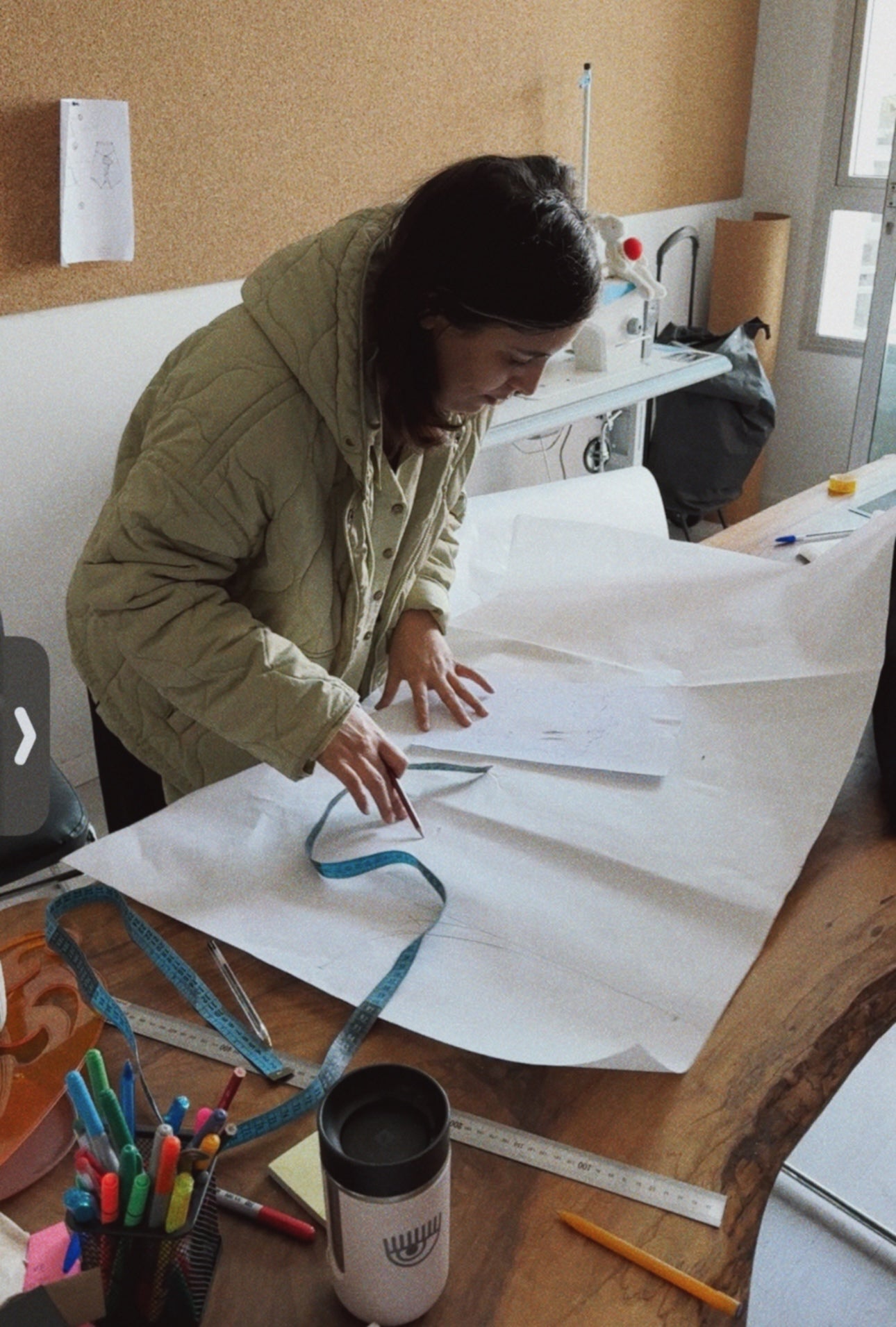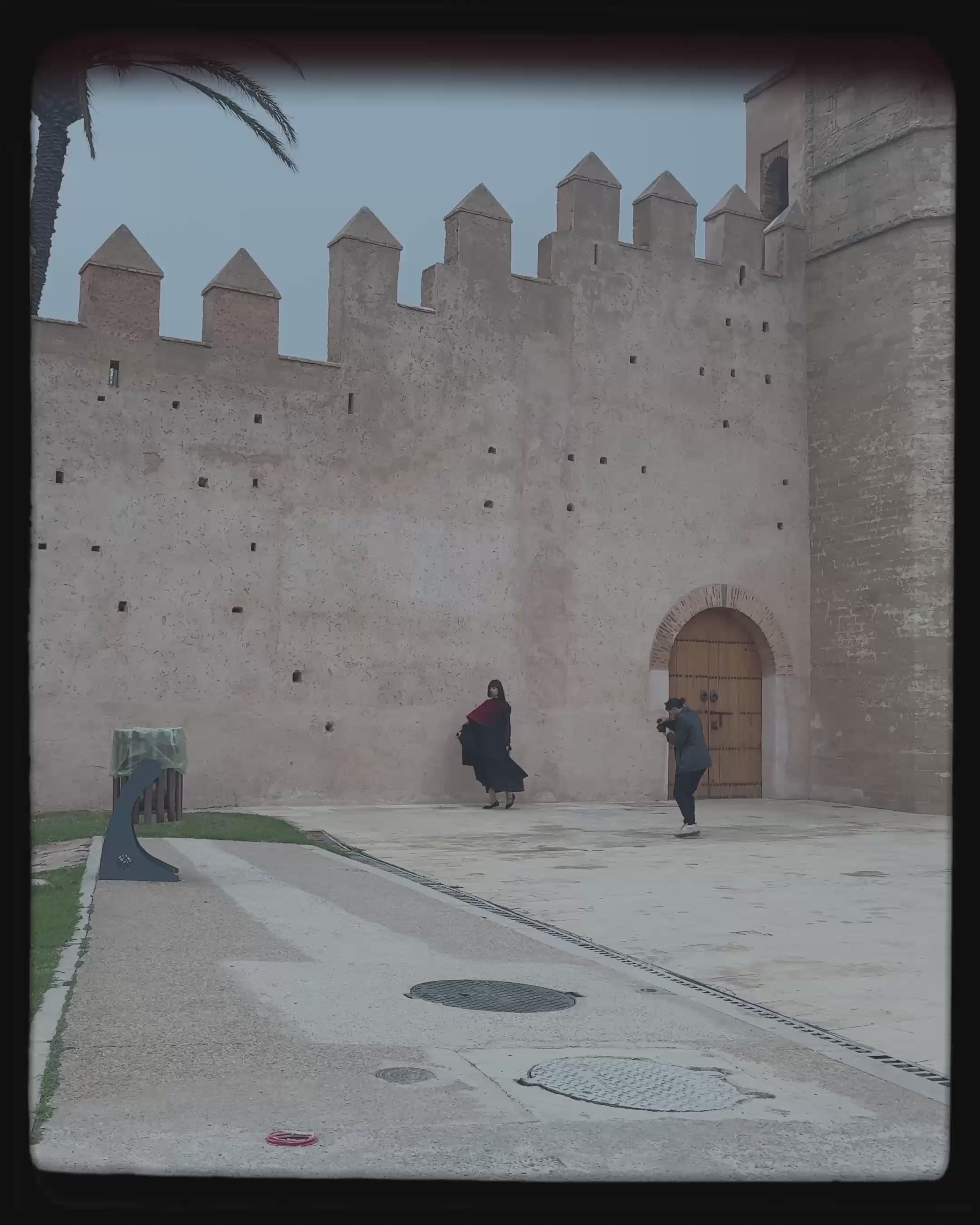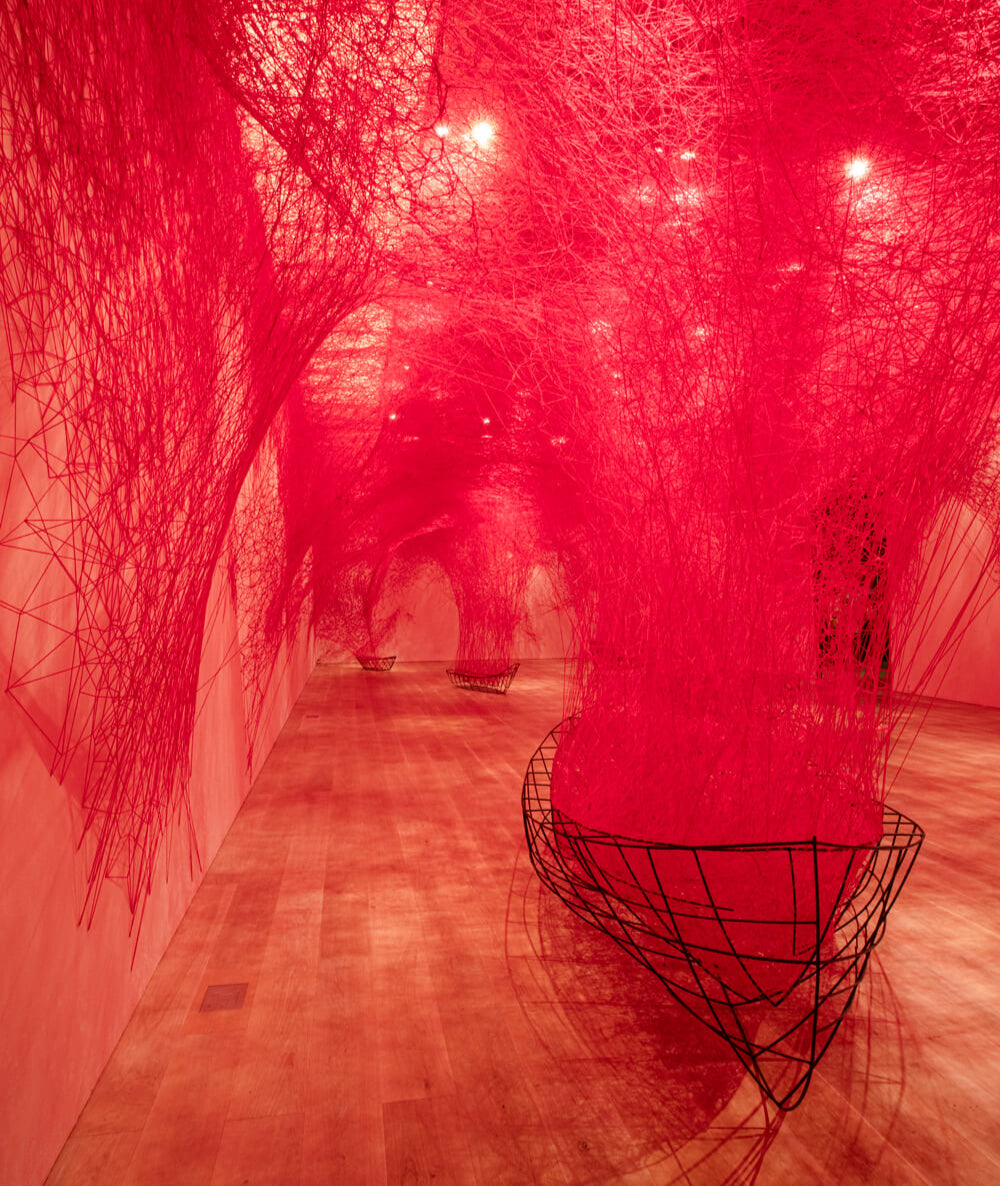
The Making of Petal
A Flower Fragment and a Story Woven in Red Thread
There are pieces that are planned, and then there are those that insist on existing. Petal was the latter. She wasn’t part of the initial vision, but she found her way—through unexpected discoveries, quiet hesitations, and moments of absolute certainty.
This is her story.

Finding the Fabric
I wasn’t planning on adding a warm outerwear piece to this first collection. My focus was on a short vest—something light, something that could complement Kuki and Leaf while feeling just right for the weather when we launched.
December 5, 2024—a day before my birthday. I went out on a mission, looking for the perfect fabric for the vest. That’s when I saw her.
It was love at first sight. Bold, unique, unforgettable. Other colors were available, but only red took my breath away. I ran my fingers across the fabric, already feeling its weight, already seeing all that it could become. But my mind wasn’t convinced.
“It’s impossible to work—we’re launching in February. The weather will be warmer by then, the verge of spring.”
“Well,” my heart whispered, “the weather is not as it used to be anyway (hello, global warming). Look around—we’re in December, and we’re going out wearing a vest over a T-shirt.”
My mind wasn’t done.
“Right before Ramadan… people will be looking for more beldi outfits.”
“Ramadan is perfect,” my heart insisted. “That’s when we go out at night, gather with family, dress beautifully. And nights are still chilly.”
A pause.
“You got a point… but it’s still risky. Let’s keep it for next year.”
“No,” my heart said. “I can’t wait. I already have the vision now.”
And just like that, my heart spoke out loud—
“3afak, bsh7al had toub?” ✨✨



And so, we started working on the pattern-making, and I literally begged her to test the prototype directly on the fabric instead of another one. I couldn’t wait to meet her—just look at me, wearing it halfway through the process 😂😭. She was breathtaking. Out of this world.
Finding More fabric 👀
I needed more. But when I returned, the fabric was gone—someone had already bought it. I gathered what was left, just eleven more meters. Not enough.
I searched further, showing the fabric to another supplier. “Have you seen this before?” I asked. He recognized it, told me he could reach out to his supplier.
Time passed. Nothing.
The next time I visited, I insisted. He called while I stood there, but apparently It was gone.
Still, I didn’t give up.
He checked again, searching beyond what was easy to find. And finally, he found it—23 meters waiting for me in Tangier.
This fabric didn’t just come to me. I had to chase it.
And maybe that’s why Petal feels different. She wasn’t an easy choice, she wasn’t part of the plan—she insisted on existing.
It wasn’t until later that I realized why she felt so familiar. Why the red thread kept pulling me toward her.
Finding the thread


Finding the name
Some names come easily. Others take time. Petal belonged to the second kind.
Naming her wasn’t just about choosing a word—it was about deciding where she belonged. Was she part of The Core Collection, a timeless piece envisioned for years to come? Or was she an Upgrade, something designed to transform and layer?
She carried both identities.
On one hand, she was bold, striking, a statement—the kind of piece that felt like an Upgrade, a new layer to elevate what’s underneath. But on the other hand, she was something I knew I wanted to keep. Not just a fleeting addition, but a presence. Something timeless. I even envisioned her in different fabrics, adapting, evolving—never bound to just one form.
She was a thread between both collections.
After reflecting, I realized the name had been there all along. Petal.
Because a petal is exactly that—a bridge between two states. It is part of the flower, yet the first to fall. It covers, yet it reveals. It carries the last breath of the bloom, yet holds the promise of the seed.
And for the poppy, this cycle is even more profound.
A poppy’s petals are red, but within them lies a dark center—a contrast, a depth. And unlike other flowers, the poppy is self-seeding. She doesn’t need intervention to continue; she simply does. When her petals fall, they don’t just disappear—they reach the soil, touch the seed, nurture what comes next.
And Petal? She does the same.
She moves between layers. She is the last thing a flower unfolds, the first thing we see when we look at one. Just like how, when worn, she becomes the final layer—the one that completes everything beneath her, the one the world sees first.
So, in the end, the choice wasn’t really a choice.
She was always Petal. ✨

Finding the image
If Finding the Fabric was a chase, and Finding the Form was a process of refinement, then Finding the Image was something else entirely. It was weightless, like Petal herself—a moment that simply happened, without struggle, without force.
The day before, I called my friend Mohcine Jannani to ask if he was free. His response made me smile.
“You have probably good luck, you are probably loved by God, because you called me just on the day I’m free and I’m in Casablanca. I’ll be traveling the next day.”
“I know that Allah loves me.” I laughed.
He asked about my vision for the photos. I sent him my inspiration board. The plan was clear:
- For Kuki and Leaf – The Exotic Garden in Bouknadel, a lush, dreamlike setting.
- For Petal – no inspiration board just Something entirely different. No greenery, no distractions. Minimal, open, almost weightless. I told him, “I want the feeling of a flower’s petal swept by the wind, falling to the earth.”
The next day, I got ready in the morning and departed from Casablanca around 2pm. The sun was shining, golden and bright. We captured Kuki and Leaf at les jardins exotiques for two hours.
Then, at 6pm, the shift happened.

As we left the gardens and turned to Petal, the sky changed. A smoky, soft, diffused light took over. It was subtle but undeniable. The exact kind of atmosphere we needed.
We had no fixed location for Petal yet. I thought about the Grand Théâtre de Rabat, but we weren’t sure if we could shoot there. The traffic slowed us down. Mohcine, always quick to adapt, suggested a detour. And on that road, we passed Chellah.
“We don’t have much time with this light,” he said. “Let’s shoot here.”
It was perfect.
At 6:35 PM, I slipped Petal on. Mohsin saw her for the first time. He paused. Then he smiled.
“This,” he said, “this is like a bomb. Your creativity just bursted with this.wow!”
We laughed, because we both felt it. This wasn’t just another piece. She was something else.
We found a stark white pedestrian crossing, freshly painted, crisp against the road. The contrast was exactly what I wanted—Petal standing out, as if suspended. Then, we turned to the sky, capturing the wind, the movement, the weightless descent.
And finally, La Muraille de Chellah. A simple terracotta wall, made of earth. It wasn’t planned, but it was right. A piece about a petal falling to the ground, captured against a backdrop made of soil. A cycle closing itself.
In just 30 minutes, we had it.
Everything felt easy. Natural. Light.
Maybe that’s why Petal’s story is so special—because every part of it, from fabric to form to name to image, carried meaning.
Mohcin understood this without me having to explain. We’ve worked together before, since my blogging days on The Cherry Blossom, and we just get each other’s vision. He called me a few months ago to say he was back in Morocco after time abroad. We met to reconnect and I showed him the collection, the videos, the pictures, he told me something that stayed with me:
“I’ve always wanted to see what a brand by you would look like. Because you are a brand yourself.”
That meant everything.
Petal now exists not just as a garment, but as a story, as a vision, as an image. A red thread woven through time, found exactly where she was meant to be.
Finding the Fabric
I wasn’t planning on adding a warm outerwear piece to this first collection. My focus was on a short vest—something light, something that could complement Kuki and Leaf while feeling just right for the weather when we launched.
December 5, 2024—a day before my birthday. I went out on a mission, looking for the perfect fabric for the vest. That’s when I saw her.
It was love at first sight. Bold, unique, unforgettable. Other colors were available, but only red took my breath away. I ran my fingers across the fabric, already feeling its weight, already seeing all that it could become. But my mind wasn’t convinced.
“It’s impossible to work—we’re launching in February. The weather will be warmer by then, the verge of spring.”
“Well,” my heart whispered, “the weather is not as it used to be anyway (hello, global warming). Look around—we’re in December, and we’re going out wearing a vest over a T-shirt.”
My mind wasn’t done.
“Right before Ramadan… people will be looking for more beldi outfits.”
“Ramadan is perfect,” my heart insisted. “That’s when we go out at night, gather with family, dress beautifully. And nights are still chilly.”
A pause.
“You got a point… but it’s still risky. Let’s keep it for next year.”
“No,” my heart said. “I can’t wait. I already have the vision now.”
And just like that, my heart spoke out loud—
“3afak, bsh7al had toub?” ✨✨

Finding the Form

I went home with five meters of that fabric, knowing it was special but not yet knowing what it would become exactly. I thought of a cape but not a classic shape. I wanted something wearable that would fit everyone, something sculptural yet uncomplicated. Something that could be layered over a lighter coat, trench, or vest but could definitely stand alone with a shirt or sweater. A simple presence.
Once I envisioned the right silhouette, I shared it with my dear Ghitta—the creative genius behind Ghitta Studio, with whom I share a workspace and a deep collaborative spirit. Together, we bring beautiful things to life, merging our complementary universes to share with the world.
And so, we started working on the pattern-making, and I literally begged her to test the prototype directly on the fabric instead of another one. I couldn’t wait to meet her—just look at me, wearing it halfway through the process 😂😭. She was breathtaking. Out of this world.
Finding More fabric 👀
I needed more. But when I returned, the fabric was gone—someone had already bought it. I gathered what was left, just eleven more meters. Not enough.
I searched further, showing the fabric to another supplier. “Have you seen this before?” I asked. He recognized it, told me he could reach out to his supplier.
Time passed. Nothing.
The next time I visited, I insisted. He called while I stood there, but apparently It was gone.
Still, I didn’t give up.
He checked again, searching beyond what was easy to find. And finally, he found it—23 meters waiting for me in Tangier.
This fabric didn’t just come to me. I had to chase it.
And maybe that’s why Petal feels different. She wasn’t an easy choice, she wasn’t part of the plan—she insisted on existing.
It wasn’t until later that I realized why she felt so familiar. Why the red thread kept pulling me toward her.
Finding the thread
At the same time that I was searching for this fabric, an exhibition was unfolding in Paris. Chiharu Shiota’s Red Threads of the Soul. It was breathtaking—webs of red thread stretching across space, tangled yet connected, forming an entire universe of fate and memory.
And just like that, it made sense.
This fabric had been waiting for me long before I knew it. She reminded me of that exhibition, of unseen connections, of the Japanese legend of the akai ito—the red thread that binds those who are meant to meet.
And the final detail? The linen lining I found for Petal was textured black, the perfect weight to hold her sculptural form. But hidden on the edge of the roll, barely noticeable, ran a single red thread. Unused. Unintentional. Just there.
Waiting.
Some things find you before you even know you’re looking for them.


In Japan, it is believed that some of us are destined to be with a particular partner in this life. An invisible red string connects your fingers together. This is called the red string of fate. In Japanese, they say, "Akai ito de musubareteru." The people connected by this thread will become part of each other's story. The thread may get tangled or stretched but it will never break. Our red threads could connect us to a great friend, a teacher, business associate, teammate, or mentor. We are all part of a scarlet tapestry. The red threads are given at birth, but we weave them together ourselves.
Finding the name
Some names come easily. Others take time. Petal belonged to the second kind.
Naming her wasn’t just about choosing a word—it was about deciding where she belonged. Was she part of The Core Collection, a timeless piece envisioned for years to come? Or was she an Upgrade, something designed to transform and layer?
She carried both identities.
On one hand, she was bold, striking, a statement—the kind of piece that felt like an Upgrade, a new layer to elevate what’s underneath. But on the other hand, she was something I knew I wanted to keep. Not just a fleeting addition, but a presence. Something timeless. I even envisioned her in different fabrics, adapting, evolving—never bound to just one form.
She was a thread between both collections.
After reflecting, I realized the name had been there all along. Petal.
Because a petal is exactly that—a bridge between two states. It is part of the flower, yet the first to fall. It covers, yet it reveals. It carries the last breath of the bloom, yet holds the promise of the seed.
And for the poppy, this cycle is even more profound.
A poppy’s petals are red, but within them lies a dark center—a contrast, a depth. And unlike other flowers, the poppy is self-seeding. She doesn’t need intervention to continue; she simply does. When her petals fall, they don’t just disappear—they reach the soil, touch the seed, nurture what comes next.
And Petal? She does the same.
She moves between layers. She is the last thing a flower unfolds, the first thing we see when we look at one. Just like how, when worn, she becomes the final layer—the one that completes everything beneath her, the one the world sees first.
So, in the end, the choice wasn’t really a choice.
She was always Petal. ✨
Finding the image

If Finding the Fabric was a chase, and Finding the Form was a process of refinement, then Finding the Image was something else entirely. It was weightless, like Petal herself—a moment that simply happened, without struggle, without force.
The day before, I called my friend Mohcine Jannani to ask if he was free. His response made me smile.
“You have probably good luck, you are probably loved by God, because you called me just on the day I’m free and I’m in Casablanca. I’ll be traveling the next day.”
“I know that Allah loves me.” I laughed.
He asked about my vision for the photos. I sent him my inspiration board. The plan was clear:
- For Kuki and Leaf – The Exotic Garden in Bouknadel, a lush, dreamlike setting.
- For Petal – no inspiration board just Something entirely different. No greenery, no distractions. Minimal, open, almost weightless. I told him, “I want the feeling of a flower’s petal swept by the wind, falling to the earth.”
The next day, I got ready in the morning and departed from Casablanca around 2pm. The sun was shining, golden and bright. We captured Kuki and Leaf at les jardins exotiques for two hours.
Then, at 6pm, the shift happened.
As we left the gardens and turned to Petal, the sky changed. A smoky, soft, diffused light took over. It was subtle but undeniable. The exact kind of atmosphere we needed.
We had no fixed location for Petal yet. I thought about the Grand Théâtre de Rabat, but we weren’t sure if we could shoot there. The traffic slowed us down. Mohcine, always quick to adapt, suggested a detour. And on that road, we passed Chellah.
“We don’t have much time with this light,” he said. “Let’s shoot here.”
It was perfect.
At 6:35 PM, I slipped Petal on. Mohsin saw her for the first time. He paused. Then he smiled.
“This,” he said, “this is like a bomb. Your creativity just bursted with this.wow!”
We laughed, because we both felt it. This wasn’t just another piece. She was something else.
We found a stark white pedestrian crossing, freshly painted, crisp against the road. The contrast was exactly what I wanted—Petal standing out, as if suspended. Then, we turned to the sky, capturing the wind, the movement, the weightless descent.
And finally, La Muraille de Chellah. A simple terracotta wall, made of earth. It wasn’t planned, but it was right. A piece about a petal falling to the ground, captured against a backdrop made of soil. A cycle closing itself.
In just 30 minutes, we had it.
Everything felt easy. Natural. Light.
Maybe that’s why Petal’s story is so special—because every part of it, from fabric to form to name to image, carried meaning.
Mohcin understood this without me having to explain. We’ve worked together before, since my blogging days on The Cherry Blossom, and we just get each other’s vision. He called me a few months ago to say he was back in Morocco after time abroad. We met to reconnect and I showed him the collection, the videos, the pictures, he told me something that stayed with me:
“I’ve always wanted to see what a brand by you would look like. Because you are a brand yourself.”
That meant everything.
Petal now exists not just as a garment, but as a story, as a vision, as an image. A red thread woven through time, found exactly where she was meant to be.












